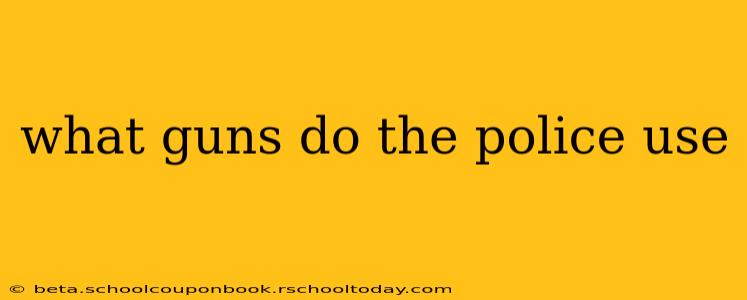What Guns Do the Police Use? A Comprehensive Overview
The firearms used by police forces worldwide vary significantly based on factors like budget, tactical needs, local laws, and agency-specific policies. There's no single "police gun," but rather a diverse range of handguns, shotguns, rifles, and less-lethal options. This overview explores the common types and considerations behind their selection.
Handguns: The Primary Sidearm
Handguns are the most ubiquitous police firearm, serving as the primary sidearm for officers. The choice often hinges on a balance of factors:
- Caliber: 9mm is currently the dominant caliber in many Western countries, favored for its balance of stopping power, manageable recoil, and higher magazine capacity compared to older .40 S&W and .45 ACP rounds. However, agencies continually evaluate ballistic performance and officer feedback to make informed choices.
- Manufacturer: Several manufacturers dominate the market, including Glock, Sig Sauer, Smith & Wesson, and Beretta. Each offers various models with differing features, like striker-fired vs. hammer-fired mechanisms, and various grip sizes to accommodate different hand sizes.
- Features: Modern police handguns often incorporate features like rail systems for attaching accessories (lights, lasers), high-capacity magazines, and improved ergonomics for comfortable and reliable handling under stress.
While 9mm is prevalent, some agencies may retain older calibers or utilize other cartridges depending on their specific needs and operational environment.
Long Guns: Rifles and Shotguns for Specialized Situations
Beyond handguns, police forces employ long guns for specific scenarios:
- Shotguns: Primarily used for breaching doors, controlling crowds (less-lethal options are increasingly preferred), and engaging targets at closer ranges where the spread of the shot is advantageous. Common gauges include 12-gauge and less frequently, 20-gauge. Some departments utilize specialized shotguns equipped with less-lethal munitions.
- Patrol Rifles: Often semi-automatic rifles chambered in 5.56x45mm NATO (.223 Remington) or 7.62x39mm (AK-47 compatible), patrol rifles provide greater range and accuracy than handguns. These are deployed in situations requiring greater firepower or extended engagement distances, such as active shooter incidents. AR-15 style platforms are frequently seen. Some agencies might employ other rifle platforms based on their operational context.
Less-Lethal Options: Prioritizing De-escalation
Increasingly, police departments prioritize less-lethal options to reduce the risk of deadly force incidents. These tools include:
- Tasers (conducted energy weapons): Designed to temporarily incapacitate subjects with electrical shocks. Different models exist with varying ranges and capabilities.
- Pepper spray/OC spray: A chemical irritant that causes temporary burning sensations and incapacitation.
- Rubber bullets/beanbag rounds: Projectiles intended to subdue individuals without causing fatal injuries. However, these can still cause serious harm if misused.
Ongoing Evolution and Considerations
The selection and deployment of police firearms are constantly evolving. Factors driving these changes include:
- Ballistics Research: Ongoing research into ammunition effectiveness, injury potential, and long-term health impacts influences choices.
- Officer Safety: Departments prioritize firearms that are reliable, easy to use under stress, and provide officers with the best chance of survival in dangerous situations.
- Public Safety: The balance between effective law enforcement and minimizing the risk of civilian injury is a crucial consideration in firearm selection and training.
- Technological Advancements: New technologies and materials continue to improve firearm design and performance, leading to ongoing updates in police arsenals.
This overview provides a general understanding of the types of firearms used by police. The specifics will vary considerably depending on the department, location, and operational requirements. It's important to remember that this is a complex issue with many nuances, and responsible firearm usage and training are paramount.
